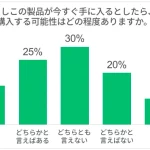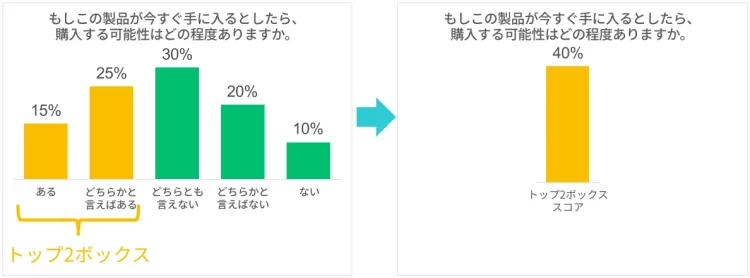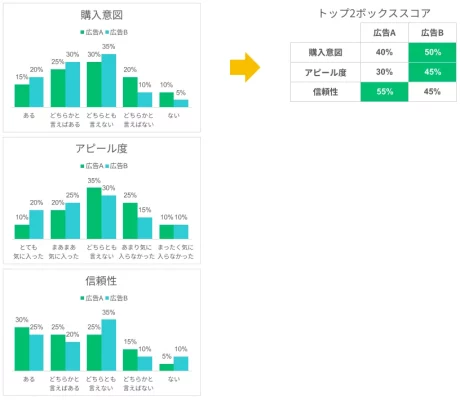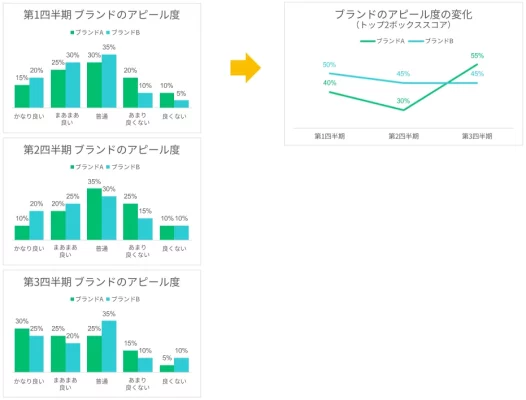トップ2ボックススコアを使ってアンケートを分析する方法

見込み客が製品を買ってくれる可能性はどのぐらいあるでしょうか。顧客は満足しているでしょうか。ブランドのアピール度は高いでしょうか。
どれを質問にした場合でも、広範な回答が寄せられると考えられ、その解釈は簡単ではないでしょう。混沌とした回答データを整理したいときは、トップ2ボックススコアの利用を検討してください。このアンケート分析手法は、主要な値をわかりやすい形で強調してくれます。
アンケート分析に、トップ2ボックススコアを使用する方法について見ていきましょう。この手法にはさまざまな形態があるので、それもご紹介します。次回、アンケートの質問を作成するときや回答をレビューするときに、トップ2ボックススコアに関する知識を活かし、アンケートの力を最大限に引き出すことができます。
まず初めに、トップ2ボックススコアとは何でしょうか。
トップ2ボックススコアの定義
トップ2ボックススコアの計算方法を具体的に理解するために、例を見てみましょう。
トップ2ボックススコアの計算方法
ペットフード会社のマーケティング担当者が、広告を何通りか作成し、ターゲット市場(ペットの飼い主)を対象にテストしようとしているとします。アンケートを実施して、ペットの飼い主が広告を見て同社の製品を買う可能性がどの程度あるかを調べます。
次のように1~5のスケールで購入意図を評価する質問をしてみましょう。
もしこの製品が今現在手に入るとしたら、購入する可能性はどの程度ありますか。
- ある
- どちらかと言えばある
- どちらとも言えない
- どちらかと言えばない
- ない
その結果、集まった回答は次のようになります。

マーケティング担当者が知りたいことは、多くの場合、広告を見て製品を購入する可能性のある人が何パーセントなのかということです。この例でトップ2ボックスに該当する回答は、最初の2つ、つまり「ある」と「どちらかと言えばある」です。トップ2ボックススコアを計算するには、この2つの回答を合計します。
15%(ある)+ 25%(どちらかと言えばある)= 40%(トップ2ボックス)

プロのヒント: SurveyMonkey分析なら、回答の選択肢を組み合わせるだけで、トップ2ボックススコアが簡単に計算できます。
トップ2ボックススコアの計算方法がわかったところで、なぜこのスコアを使うのかを考えてみましょう。
トップ2ボックススコアを使用する理由
1) 分析が簡単になる。数値が1つしかないので、5つ以上の数値を検討する場合に比べて手間がかかりません。
2) すばやく簡単に比較できる。ブランド間、あるいは刺激(たとえばコンセプトテスト)間で結果を比較するときに、トップ2ボックススコアを使えば結果を並べて効率的に比較できます。
ここで、先ほど見たペットフード会社の例に戻りましょう。購入意図についてだけでなく、アピール度と信頼性についても質問したとします。トップ2ボックススコアを使うと、解釈の難しい大量のグラフの代わりに、すっきりとしたシンプルなスコアカードを作成できます。

3) トレンドが見つかりやすい。長期的に指標を追跡する場合、トップ2ボックススコアを使うと、データに潜むトレンドが特定しやすくなります。
たとえば、ブランドのアピール度を競合他社のアピール度と比較し、その変化を追跡するとしましょう。各ブランドの相対的なイメージを5段階のスケールで評価してもらいます。四半期ごとに結果を得て追跡し、各ブランドの変化を並べて確認します。
トップ2ボックススコアを使えば、長期的な変化を1つのグラフで確認できます。

自分の直感をテストしたいなら
SurveyMonkey Audienceなら、全世界の消費者から意見がもらえます。
各種のトップ2ボックススコア
トップ2ボックススコアには、いくつか種類があります。ここでは一般的なものをご紹介しましょう。
トップボックススコア
最も肯定的な回答だけが必要な場合は、トップボックススコアを使用します。たとえば、顧客維持率の改善が目的で、顧客に満足度を星の数で評価してもらう場合は、5つ星を付けてくれる顧客の割合を増やすことが目標になるでしょう。
当社のサービスをどのように評価しますか。
- ★★★★★
- ★★★★
- ★★★
- ★★
- ★
トップ ボックス スコアを割り出すには、最高評価を選択した回答者の割合を計算するだけです。回答者の20%が5つ星を付けたなら、トップ ボックス スコアは20%です。
トップ3ボックススコア
リッカート尺度のスケールが5段階を超える場合は、トップ3ボックススコアを使用します。計算方法はトップ2ボックスと同様で、上位3つの肯定的な回答を合計します。
当社のカスタマーサービスにどの程度満足しましたか。
- かなり満足
- とても満足
- 満足
- 普通
- 不満
- とても不満
- かなり不満
ボトム2ボックススコア
リッカート尺度の質問で、否定的な回答を集計したい場合は、トップ2ボックスではなくボトム2ボックスを使用します。たとえば、SurveyMonkeyのブランド コンバージョン アンケート テンプレートには、次のようなブランドロイヤリティの質問があります。
次回購入するときに、別のブランドに変える可能性はどの程度ありますか。
- ある
- どちらかと言えばある
- どちらとも言えない
- どちらかと言えばない
- ない
忠実な顧客を数値化したいなら、ボトム2ボックススコアを使用して、下位の2つの回答(「どちらかと言えばない」・「ない」)を合計します。
トップ2ボックススコアの重み付け
場合によっては、トップ2ボックスをさらに掘り下げたいこともあるでしょう。2種類の製品コンセプトを提示して購入意図を調べた結果、トップ2ボックススコアが次のような内訳になったとします。
製品A
トップ2ボックススコア: 40%
購入する可能性がある: 15%
どちらかと言えば購入する可能性がある: 25%
製品B
トップ2ボックススコア: 40%
購入する可能性がある: 30%
どちらかと言えば購入する可能性がある: 10%
この場合、どちらの製品を見てもトップ2ボックススコアが同じなので、同じ結論を下す可能性があります。しかし、製品Bの方は「購入する可能性がある」という回答が製品Aの2倍であり、購入意図は明らかに製品Aより高いと結論できます。

この例からわかるように、トップ2ボックススコアだけに頼ると、特に比較するスコアに差がない場合に正しい結論が出せないことがあります。重み付けトップ2ボックススコア(またはトップボックススコア)を使うと、結果がより明確になり、広告を再テストしたり標本サイズを拡大したりする必要がなくなります。
重み付けトップ2ボックススコアの計算方法
重み付けトップ2ボックススコアは、次のような式で計算します。
(トップボックススコア × トップボックスの重み)+(第2ボックススコア × 第2ボックスの重み)= 重み付けトップ2ボックススコア
この式で、やや主観的な要素があるとすれば、それは重みです。トップ2ボックススコアの重みは、経験則では次のように決定します。
- トップボックスと第2ボックスの重みは同じにしない
- 2つの重みは合計して1になる
- トップボックスの重みは、第2ボックスの重みより大きいのが普通です。なぜなら、リッカート尺度の質問において、トップボックスは最も肯定的な回答であり、市場でのパフォーマンスを最も的確に予測するものだからです。
- 重みを決めるときは、製品カテゴリーや、消費者の意思決定レベルを考慮することが大切です。値段が手ごろで買いやすい製品(たとえば歯磨き粉)の場合は、消費者から正確な回答が得られるため、トップボックスに高い重みを付けます。購入についてよく考える必要がある製品(たとえば自動車)の場合は、トップボックスにわずかに高い重みを付けます。
トップ2ボックススコアは、市場調査に欠かせない手法です。広告テスト、製品フィードバック、ブランド認知度などの結果をトップ2ボックススコアで分析すれば、効率が上がり、適切な判断につながります。
その他のリソースを見る

ツールキットディレクトリ
フィードバックを自分の職務や業種で活用するためのツールキットを開拓しましょう。

アンケートテンプレート
400種類以上の専門家作成のカスタマイズ可能なアンケートテンプレート。SurveyMonkeyで優れたアンケートをすばやく作成・送信しましょう。

p値計算ツール: p値の計算方法
SurveyMonkeyのp値計算ツールでp値を計算しましょう。また、p値の計算方法や解釈方法もステップバイステップで学べます。

リクエストにお応えして複数アンケート分析機能が新登場
SurveyMonkeyの新しい複数アンケート分析機能を使うと、アンケート結果を1つのビューにまとめて分析できます。